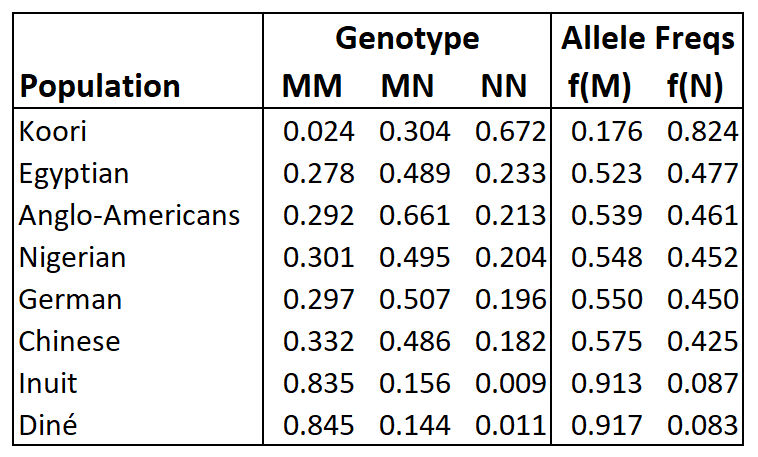
MN Blood Group system in Humans

The MN
blood group system is under the control of an
autosomal locus found on Chromosome 4, with two alleles
designated LM and LN.
The blood-type is due to a glycoprotein present on the
surface of red blood cells, which behaves as a native antigen.
Phenotypic expression at this locus is co-dominant
because an individual may exhibit either one or both antigenic
substances. Frequencies of the two alleles vary widely among
human populations: note variation in the data above by continent
of origin. For example, although Australian Koori differ
markedly from Arctic Inuit, the latter are similar to
southwestern Diné (Navajo). Both of the later are North
American Indigenous peoples.
Carr
(2021) describes additional MN data from
various populations in the Philippine Islands, based on the
original presentation by Arcellana et al. (2011).
NB: The MN system is
one of 48 recognized blood group systems, the most widely
recognized are the ABO and Rh systems. Because
these latter in particular can determine the success of blood
transfusions, there are a great deal of clinical data available
from different countries and (or) ethnic groups.These constitute
some of the earliest data on human genetic variation, and their
Mendelian genetics were appreciated well before their protein,
immunogenetic, and DNA
natures were known. As such, they figure prominently in
early population genetics.
Human population
genetic data were formerly collected with less appreciation for
ethnic identities and differentiation than is standard nowadays.
Blood group frequency data are often taken from hospital
records, which may or may not include place or group of origin.
For example, in the table above, the "Nigerian" data
might come from any of the three major ethnic groups (Hausa,
Igbo, Yoruba) or a combination of these and others. "Chinese"
likely means the predominant Han ethnicity, but may not. "Anglo-Americans"
in
the original source are labelled "White", and are likely
a highly admixed combination of Northern European ancestry. As
data for a mathematical exercise, the numbers are useful. For
inferences about human evolution and diversity, a more nuanced
approach is necessary.